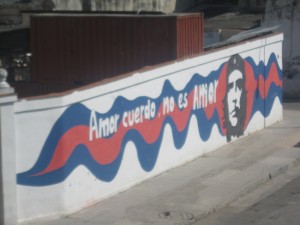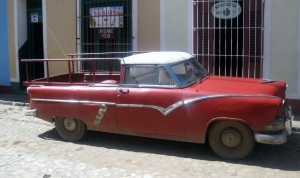Cuba in Symbols
March 25, 2012 by mamielke
Upon returning to the United States, all of my friends and family members have asked me about my trip to Cuba. Immediately, my mind wanders to the symbols of Cuba. I found myself thinking of the notion of Cuban symbolism while in the country, and I imagine that I will be trying to comprehend this complex issue for a while.
To promote their tourist industry, Cuba has attempted to export certain symbols of the country that will be appealing to foreign tourists. This isn’t so different from other nations who do this in attempt to increase tourism as well as domestic revenues. This can be seen more concretely in billboards at airports, or just through a collected consciousness. For me in my tourist mindset, the images of a mojito, an antique car, and a Cuban musician were conjured in my mind. However, to placate my intellectual mind, the images of critical Cuban history; the 26th of July Movement, the Castro brothers, Che Guevara, and the embargo are the symbols that were very highly prioritized in my consciousness in my preparation for our class trip to Cuba.
Being in Cuba, however, was a very different story. I found it so interesting what symbols Cuba chose to represent throughout the country. I knew from literature and previous class discussions that Che Guevara’s face was a very prominent image in Cuba as a pictorial depiction of the revolution and all that it stands for. However, I had no idea that the images of the Cuban Five would be such a profound symbol of nationalism (and anti-U.S. sentiment) throughout the nation. To be honest, I did not even know about the plight of these men, who are currently imprisoned in the United States for “espionage,” until our visit to ICAP on one of the first days in Cuba. This particular symbol was everywhere in Cuba. For example, the images of these five were even at Ernesto Che Guevara’s monument and mausoleum.
It was also interesting to consider what Cuba did not promote as a symbol of nationhood. While over 300,000 Cubans were sent to Angola during Cuba’s 15 year involvement in Africa, there is no national monument to celebrate the roughly 2,000 people who perished in the international conflicts. The memories of Angola were barely visible in Cuba, despite the fact that Cuba’s participation in Angola could arguably represent revolutionary ideals in their most pure form.
Another issue that crossed my mind throughout the trip is the endangerment of these symbols. For example, the antique, American car has become a symbol of Cuba for both all-inclusive resort occupying tourists and Cuban historians alike. However, if and when the embargo ends, these cars will all but disappear. And even if as the embargo continues, as I witnessed on our trip, there seems to be a steady progression of newer cars entering the picture. In Havana, I saw probably as many Japanese or European cars in Cuba as I saw old, American cars. The trend of being able to import these non-American cars will doubtlessly increase with the rise of tourism and the hopeful lessening of the embargo’s effects.
And, if and when the Cuban five are released, what will happen to the thousands of billboards and images of street art that demand their release? Will they simply be whitewashed, or will a new message about victory replace the pessimism that these images communicate?
Cuba has purposefully chosen which images should pictorially represent their country, and while there is a bit of a difference between the tourist and academic mindset, in the end, all visitors to Cuba are treated to the same images of a country that is trying to promote its own agenda in a world of competing images. 
Leave a Reply
You must be logged in to post a comment.


